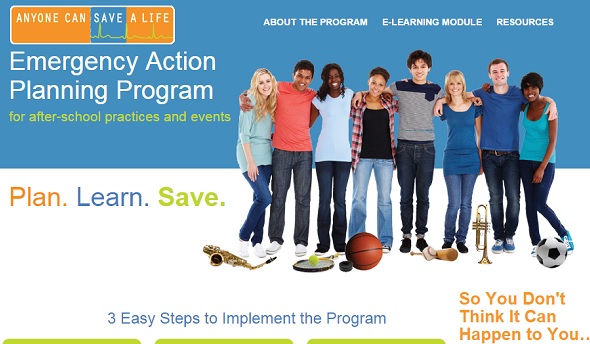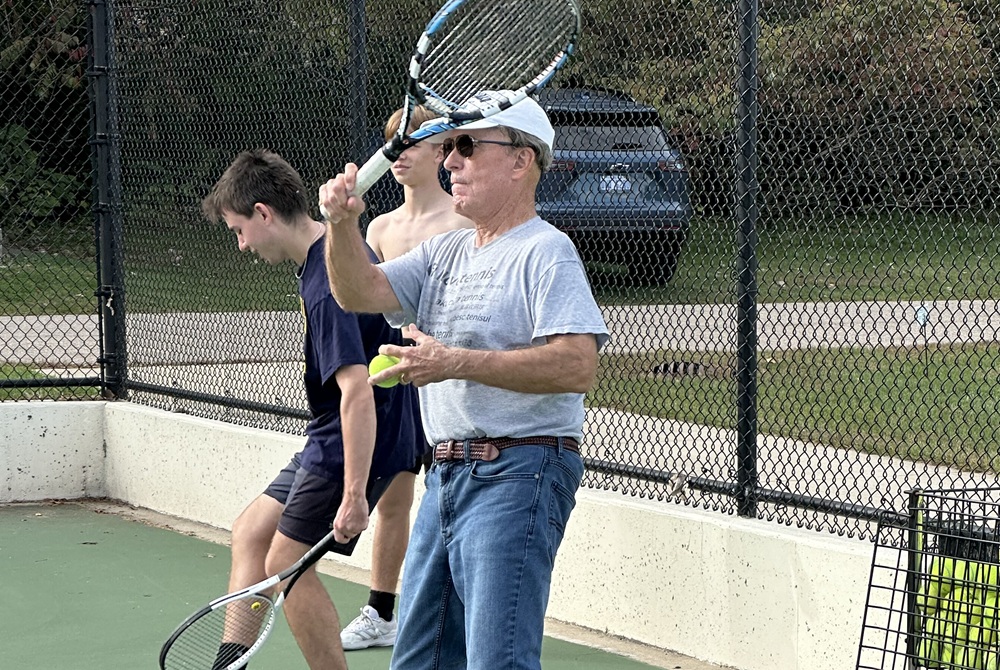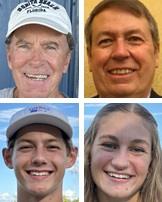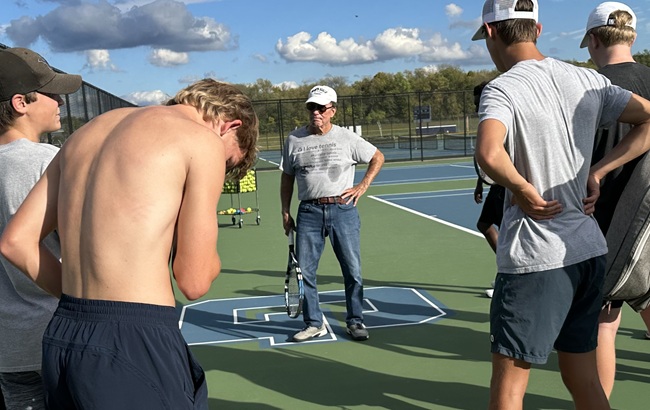
'Anyone Can Save a Life' Aims to Prepare
July 28, 2015
By Rob Kaminski
MHSAA benchmarks editor
It was 2008 when Jody Redman and staff at the Minnesota State High School League developed an emergency action plan to provide guidance and procedure in the event of sudden cardiac arrest during scholastic athletic competition.
The desired response from schools upon receipt of the plan was, well, less than enthusiastic.
“Only about 40 percent of our schools used the information and implemented the program,” said Redman, associate director for the MSHSL. “Our focus was completely on sudden cardiac arrest, that being the worst-case scenario regarding athletic-related health issues.”
The MSHSL asked the University of Minnesota to survey its member schools, and results showed that the majority of schools not on board simply felt a sudden cardiac arrest “would never happen at their school.” Naive or not on the schools’ parts, that was the reality – so Redman went back to revise the playbook.
“We expanded the plan to deal with all emergencies, rather than specific incidents,” Redman said. “Now it’s evolved so that we are prepared to deal with a variety of situations which put participants at risk. We shifted gears and got more schools to participate.”
Did they ever. And not just in Minnesota.
This summer, the “Anyone Can Save a Life” program, authored by the MSHSL and the Medtronic Foundation, is being disseminated to high schools nationwide with the financial support of the NFHS Foundation. The program will reach schools in time for the 2015-16 school year.
Once received, schools will find that there are two options for implementation, via in-person training or online.
“The in-person method is facilitated by the athletic administrator with the assistance of a training DVD” Redman said. “The important element is the follow through, ensuring coaches return their completed Emergency Action Plan (EAP). With the e-learning module on anyonecansavealife.org, individuals will complete an e-learning module that will walk them through the details of their specific plan, and as they answer questions, the information will automatically generate a PDF of the Emergency Action Plan (EAP) which they can edit at a later date as information changes.”
Schools will find five major components of the program to be received this summer: the first is an implementation checklist for the AD, explaining their role. Next are sections for in-person training, online training and event staff training. The last item contains a variety of resources that will ensure the successful implementation of a comprehensive emergency response to all emergencies.
Generally speaking, the program prompts schools to assemble preparedness teams, broken into four categories: a 911 team, a CPR team, an AED team and a HEAT STROKE team. The groups are made up of coaches and their students who will be in close proximity to all after-school activities.
“The reality about school sports is, at 3:30 every day the office closes and any type of medical support ceases to exist,” Redman said. “We then send thousands of students out to gyms, courts, fields and rinks to participate without systemic support for emergencies. This program puts into place that systemic support.”
Another stark reality is that the majority of schools in any state do not have full-time athletic trainers. Even for those fortunate enough to employ such personnel, it’s most likely the training “staff” consists of one person. That one body can only be in one place at one time, and on widespread school campuses the time it takes to get from one venue to another could be the difference between life and death.
“Athletic trainers can champion the program, but someone needs to oversee that every coach has a completed EAP in place,” Redman said. “For every minute that goes by when a cardiac arrest occurs, chance for survival decreases by 10 percent.”
Thus, it’s imperative to train and grant responsibility to as many people as possible, including student-athletes. In fact, students are a vital component to having a successful EAP. Students will be put in position to call 911, to meet the ambulance at a pre-determined access point, to locate the nearest AED, to make sure emersion tubs are filled for hot-weather practices, and for those who are trained, to assist with CPR. Coaches will identify students at the beginning of the season and prior to an emergency taking place. They will provide them with the details of the job they are assigned so they will be ready to assist in the event of an emergency.
“We have game plans for every sport, and for every opponent on our schedule,” Redman said. “But we don’t have a plan to save the life of a member of our team or someone attending a game at our school.
“This is about developing a quick and coordinated response to every emergency so we give someone in trouble a chance at survival, and then practicing it once or twice a season. We have ‘drop the dummy’ drills where we drop a dummy and evaluate how it went, and how everyone performed. In one scenario, it’s the coach that goes down, and then you have a group of 15- or 16-year-olds standing there. That’s why students have to take ownership of this, too.”
The key to an effective emergency action plan is to utilize and empower students in every sport and at every level to be a part of the response team. Following are brief descriptions of the teams.
The 911 Team
- Two students will call 911 from a pre-determined phone and provide the dispatcher with the location and details of the emergency.
- Two students will meet the ambulance at a pre-determined access point and take them to the victim.
- Two students will call the athletic trainer, if one is available, and the athletic administrator and alert them to the emergency.
The CPR Team
- The coach is the lead responder on this team and is responsible for attending to the victim and administering CPR, if necessary, until trained medical personnel arrive.
- One person is capable of providing effective CPR for approximately two minutes before the quality begins to diminish. Having several students trained and ready to administer CPR will save lives.
The AED Team
- Two students will retrieve the AED and take it to the victim.
- Two students will physically locate the athletic trainer, if one is available, and take him or her to the victim.
The Heat Stroke Team
- Two students identify locations of emersion tub, water source, ice source and ice towels.
- Two students prepare tub daily for practices and events.
For more information, visit anyonecansavealife.org or contact the MSHSL.

Built Right, No Rebuild Needed: Cornelius Taking Gull Lake Back to Tennis Finals
By
Pam Shebest
Special for MHSAA.com
October 21, 2025
RICHLAND – Once the boys season ends later this week, Roger Cornelius will begin preparing for his 50th year as varsity girls tennis coach at Gull Lake High School.
 That tenure may have been cut short at 22 years, if not for the Gull Lake tennis community.
That tenure may have been cut short at 22 years, if not for the Gull Lake tennis community.
In January 1998, Cornelius’ 16-year-old daughter, Lindsay, died as a result of a winter car crash.
He had recently ended the fall season with the girls team and “I didn’t know if I could (coach) the boys that spring,” he said, still emotional when talking about the tragedy.
One of his former students, Jason Ryan, now a vascular surgeon at Beacon Kalamazoo Hospital, contacted Cornelius.
“He and one or two other guys talked with me and, if not for them, I would have quit tennis,” Cornelius said. “I decided to continue with tennis, and I’m glad I did. I found out that God was going to carry me through the toughest time of my life. The tennis community was really big for me back then. Richland, especially, came beside me and lifted me up.”
Although tennis is his sport of choice, Cornelius played football at Western Michigan University and was first hired at Gull Lake in 1975 to help with the football program. He jumped at the chance to coach the tennis team that spring and has coached either the boys or girls, and sometimes both, every year since.
He has been named Regional Coach of the Year several times and was enshrined in the Michigan High School Tennis Coaches Association (MHSTeCA) Hall of Fame in 2018.
Cornelius will lead the boys (12-2-1) to the MHSAA Lower Peninsula Division 3 Finals this Friday and Saturday at Midland Tennis Center. The Blue Devils finished 10th the last two years, earning eight points both times.
In a rebuilding year after losing all four singles and two doubles players to graduation, Cornelius was surprised and thrilled that this year’s team earned 20 points at its Regional, finishing second to St. Joseph and qualifying for the Finals.
At the beginning of the season, senior Peyton Orley said he wasn’t sure how good the team would be.
“Last year at the beginning of the season, we could tell we had a really good team,” Orley said. "This year, we lost a lot of our seniors and it didn’t look promising for states.
“Everyone on the team was mission-motivated to get to the state tournament.”
 Orley pairs with senior Sullivan Abegg at No 1 singles and the pair did their part, winning their Regional flight. For Abegg, it was a three-peat after taking the title at No. 3 doubles two years ago and No. 2 doubles last year.
Orley pairs with senior Sullivan Abegg at No 1 singles and the pair did their part, winning their Regional flight. For Abegg, it was a three-peat after taking the title at No. 3 doubles two years ago and No. 2 doubles last year.
The Blue Devils are led at No. 1 singles by freshman Kade DeMaagd, whose father also played for Cornelius.
“Kade’s got the best strokes on the team,” the coach said.
Lucas Nichols, at No. 4 doubles, is the other freshman in the lineup. The other three seniors are Max Uppal (No 3 singles) and Dylan Piwko and Evan McCann, both doubles players. Three juniors, who all play doubles, are Jaden Jones, Jackson McDermott and McGuire Abegg. Two sophomores round out the singles flights: Jake Worgess at No. 2 and Jacob Nichols at No. 4.
Comparing old & new
Cornelius said there isn’t much difference between the tennis players today compared to those 50 years ago.
“I think what’s changed the most is today’s athletes have so many different options, so many different interest areas,” he said. “A lot of the kids have early college classes, some of them have to come to practice from off site and so many things are happening, whether it’s the Model United Nations or tutoring someone at the high school or DECA. I think that’s the biggest difference.”
While the boys are competing in Division 3, the girls are in Division 2, a more difficult road to the Finals, Cornelius said.
“It does make it pretty tough for the girls to make it out of Division 2 with the Mattawans, Portage Central, St. Joe, Battle Creek Lakeview,” he said.
Orley’s sister, Ava, a junior who plays at No. 1 doubles, said the girls team has already bonded.
“We build our team off loving each other,” she said. “It’s not everyone out for themselves, it’s all of us (working together). We focus on being a good role model.
"We’ve had coaches tell us how we played with class and how it’s an honor to play us because we learned from (Cornelius) that you always want to be a good sport.”
Competitive, compassionate
Cornelius, who taught French at the high school for 32 years, currently tutors French-speaking African and Haitian families for the district.
“I tutor the kids and work with the families,” he said. “It’s vastly different than what I did in the classroom. The greatest thing that’s ever happened to me in my nearly 50 years working with Gull Lake schools was working with a little African boy who was blind.”
Cornelius and some friends pooled money to take the boy to a specialist in Grand Rapids. The specialist asked Cornelius to translate for the mother that he thought he could help the young boy regain some sight.
“The two surgeries were successful,” said Cornelius, choking up a bit with emotion. "He has to wear glasses, but he can see. It’s the high watermark of my life.”
That compassion is visible on the tennis courts, said retired Allegan coach Gary Ellis, now a volunteer assistant tennis coach at the school.
 “I’ve known Roger since 1977,” Ellis said. “We started competing against each other when he started coaching the boys.”
“I’ve known Roger since 1977,” Ellis said. “We started competing against each other when he started coaching the boys.”
He said that although Cornelius wants to win and likes to compete, “at the same time, he’s got a good perspective on the whole thing and the value of high school sports, and tennis in particular. He’s very positive, both with his team and with the opponents.”
Cornelius was so supportive of opponents that one year Ellis’ girls team invited the Gull Lake coach to their awards banquet at the end of the season.
“He had a conflict and couldn’t attend, but he sent a really nice letter to the girls,” Ellis said.
Cornelius makes it a point to talk with opponents, both coaches and players.
“I love to get to talk to the kids that I would never get to talk with,” he said. “My favorite is Battle Creek Central because they have struggles that most of us at Gull Lake don’t know about.
“For them to commit their spring or their fall to tennis, that’s a major decision. I want to make darn sure that after the match, I get to meet every one of them, talk with them, talk with their coach.”
Cornelius doesn’t expect this to be his last season.
“I will step down when the good Lord says, ‘I think it’s time,’” he said. “And I don’t think it’s time quite yet.
“I wouldn’t mind if they put on my gravestone ‘Loved God, Loved People.’”
 Pam Shebest served as a sportswriter at the Kalamazoo Gazette from 1985-2009 after 11 years part-time with the Gazette while teaching French and English at White Pigeon High School. She can be reached at [email protected] with story ideas for Calhoun, Kalamazoo and Van Buren counties.
Pam Shebest served as a sportswriter at the Kalamazoo Gazette from 1985-2009 after 11 years part-time with the Gazette while teaching French and English at White Pigeon High School. She can be reached at [email protected] with story ideas for Calhoun, Kalamazoo and Van Buren counties.
PHOTOS (Top) Richland Gull Lake tennis coach Roger Cornelius hits with his players during practice this season. (Middle) Clockwise from top left: Cornelius, assistant Gary Ellis, junior Ava Orley and senior Peyton Orley. (Below) Cornelius talks things over with his team. (Photos by Pam Shebest.)

